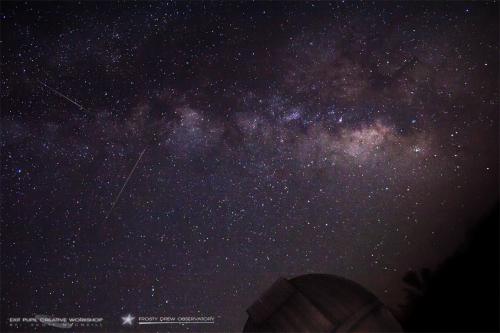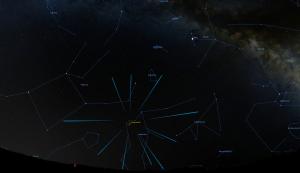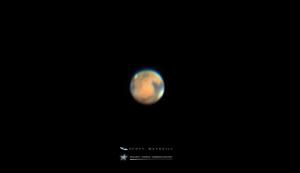Astronomical Potpourri for May
I never tire of observing “burning rocks” falling from the sky. While these remnants of comets or pieces of asteroids really do not burn as such, they do disintegrate due to friction as they slam into Earth’s dense atmosphere at supersonic speeds. Though I haven’t kept a consistent record of all the meteors I’ve seen, I think a conservative estimate of my meteor counts from the early 1970s to present would total between 1,500-2,000 observations. That’s a lot of hours scanning the skies for the opportunity to view the sometimes brilliant demise of a piece of solar system debris. But occasionally one is rewarded with a fireball that lights up the sky during its fiery demise.
The upcoming May Eta Aquarids meteor shower provides everyone an opportunity to observe 10-15 shooting stars per hour at peak on the night of May 6-7. However, to view these “burning rocks” to best advantage you’ll have to observe between midnight and dawn on the morning of the 7th. This very old stream of particles was shed by Comet Halley many eons ago, and due to its orbit is best seen in the southern hemisphere. And in fact, the Eta Aquarids are our southerly neighbors’ best display of the year. These swift and yellow shooting stars enter the Earth’s upper atmosphere head-on at 41 miles per second.
The meteor shower’s name comes from the fact that the meteors radiate from the constellation of Aquarius. Aquarius will be about 12 degrees above the east-southeast horizon at the 4:00 a.m. hour. The Eta Aquarids radiant point is in the Water Urn asterism (looks like a Y-shaped group of stars). While the meteors appear to radiate from this region of the sky they can be seen anywhere. Unfortunately a bright waning gibbous Moon will be in the nearby constellation of Capricornus, thereby reducing the peak number of meteors a little. However, because the Eta Aquarids come in so fast, you can still expect a few bright ones to be seen despite the Moon’s presence.
For many casual stargazers Aquarius can be a little difficult to recognize even without bright moonlight. But look towards the east-southeast and scan around the sky. The meteors can appear anywhere. The Moon will rise around 1:33 a.m. locally, so you can use it as a general guide to find the sky location. Dawn’s early light begins early at the beginning of May, so the eastern sky will begin brightening around 4:30 a.m.
In addition, that same morning you can glimpse Mars and Saturn. Pumpkin colored Mars will be to the upper right of the Moon and to the left of the teapot asterism in Sagittarius. Meanwhile, Saturn will be farther up and to the right of Mars, to the left of the teapot’s lid. You can locate Saturn ahead of time on the morning of the 4th when it will be less than two degrees from the Moon. That same evening, Venus and Taurus’s bright star Aldebaran, plus the Hyades and Pleaides star clusters will be above the western horizon after sunset. It promises to be a beautiful sky scene to photograph.
For several months there has been a dearth of planets in the pre--midnight hours for casual stargazers to explore and enjoy. That situation has been gradually changing as we transitioned from winter into spring. Jupiter is now visible before midnight during a reasonable hour. Recently it has remained low in the east during the open nights at the local observatories. However, on May 9, Jupiter is at opposition, meaning it is opposite the Sun in the sky. When the Sun sets Jupiter will rise. This time is also when Jupiter is at its closest to the Earth, this year just over 409,000,000 miles away. It will still be a few weeks before Jupiter will rise high enough in the sky to clear tree-lines and interfering buildings from many locations. My June column will contain a Jupiter observing guide for those of you with telescopes, or for those of you who wish to be well informed when they visit Rhode Island’s finest observatories. Once Jupiter is positioned higher in the sky and away from horizon haze will a keen-eyed observer see a wealth of detail.
For those of you who can’t wait until next month, Jupiter is currently in the constellation of
Libra. Libra, the Scales, is not one of the most recognizable constellations to identify. So on May 9th Jupiter rises at 7:35 p.m. in the east-southeast sky within Libra’s borders. Jupiter will be the brightest object in that area of the sky so it will be easy to locate. Bright star Spica, in neighboring Virgo, will be about 24 degrees to the upper right of Jupiter.
Later during the summer Saturn and Mars will be well placed for observation. I will write about observing these two worlds in a future column.
If you do not have your own telescope but wish to explore the heavens in more detail, please visit Rhode Island’s observatories during their free public observing sessions. Seagrave Memorial Observatory in North Scituate is open to the public every clear Saturday night. Ladd Observatory in Providence is open every clear Tuesday night. The Margaret M. Jacoby Observatory at the CCRI Knight Campus in Warwick is open every clear Thursday night. Frosty Drew Observatory in Charlestown is open every clear Friday night year-round. Be sure to check all the websites for the public night schedules and opening times before visiting these facilities, especially as we approach the summer months when the sun sets much later.
Clear skies to everyone!
Dave Huestis
- Author:
- David Huestis
- Entry Date:
- May 1, 2018
- Published Under:
- David Huestis's Columns





